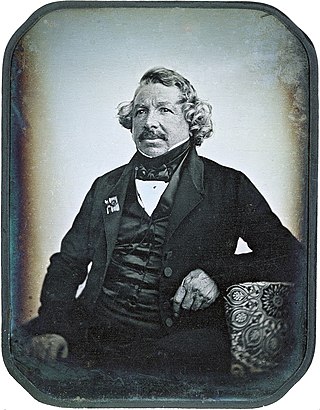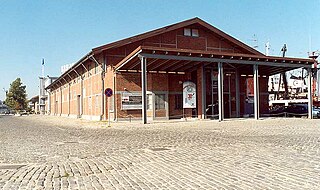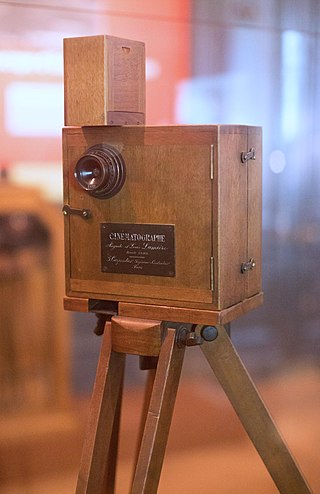
The magic lantern, also known by its Latin name lanterna magica, was an early type of image projector that used pictures—paintings, prints, or photographs—on transparent plates, one or more lenses, and a light source. Because a single lens inverts an image projected through it, slides were inserted upside down in the magic lantern, rendering the projected image correctly oriented.

A camera obscura is the natural phenomenon in which the rays of light passing through a small hole into a dark space form an image where they strike a surface, resulting in an inverted and reversed projection of the view outside.

Daguerreotype was the first publicly available photographic process, widely used during the 1840s and 1850s. "Daguerreotype" also refers to an image created through this process.

Cinematography is the art of motion picture photography.

Louis Aimé Augustin Le Prince was a French artist and the inventor of an early motion-picture camera, and director of Roundhay Garden Scene.

Mülheim, officially Mülheim an der Ruhr and also described as "City on the River", is a city in North Rhine-Westphalia in Germany. It is located in the Ruhr Area between Duisburg, Essen, Oberhausen and Ratingen. It is home to many companies, and two Max Planck Institutes.

The history of photography began with the discovery of two critical principles: The first is camera obscura image projection, the second is the discovery that some substances are visibly altered by exposure to light. There are no artifacts or descriptions that indicate any attempt to capture images with light sensitive materials prior to the 18th century.

A front projection effect is an in-camera visual effects process in film production for combining foreground performance with pre-filmed background footage. In contrast to rear projection, which projects footage onto a screen from behind the performers, front projection projects the pre-filmed material over the performers and onto a highly reflective background surface.

Precursors of film are concepts and devices that have much in common with the later art and techniques of cinema.

The history of the camera began even before the introduction of photography. Cameras evolved from the camera obscura through many generations of photographic technology – daguerreotypes, calotypes, dry plates, film – to the modern day with digital cameras and camera phones.

Camera Obscura & World of Illusions is a tourist attraction located in Outlook Tower on the Castlehill section of the Royal Mile close to Edinburgh Castle. The original attraction was founded by entrepreneur Maria Theresa Short in 1835 and was exhibited on Calton Hill. Outlook Tower has been a museum since the late 1890s and is currently home to many interactive exhibits, including the original Camera Obscura.

Anamorphic format is the cinematography technique of shooting a widescreen picture on standard 35 mm film or other visual recording media with a non-widescreen native aspect ratio. It also refers to the projection format in which a distorted image is "stretched" by an anamorphic projection lens to recreate the original aspect ratio on the viewing screen. The word anamorphic and its derivatives stem from the Greek anamorphoo, compound of morphé with the prefix aná.

The Eisenbahnmuseum Bochum-Dahlhausen is a railway museum situated south of the city of Bochum in the state of North Rhine-Westphalia, Germany. It was founded by DGEG, the German Railway History Company in 1977 and is based in a locomotive depot that was built between 1916 and 1918 and ceased operation in 1969. Then DGEG took over the whole area of 46,000 square metres and built up the biggest railway museum in Germany. In the middle of the museum, there is an engine shed with fourteen tracks. A preserved turntable, coaling, watering, and sanding facilities are still in operation. This museum is integrated into The Industrial Heritage Trail a route of monuments from the history of the industry.

The Cinema Museum of Thessaloniki is a museum in Thessaloniki, Central Macedonia, Greece. It was founded in 1995 following a decision by the Organization for Thessaloniki, Cultural Capital of Europe 1997. Today it is part of the Thessaloniki Film Festival with its own management committee. It is housed in Warehouse 1, a listed building on quay 1 in the harbour, at the end of the old sea front near Aristotelous Square.

The Museum of Precinema is a museum in the Palazzo Angeli, Prato della Valle, Padua, Italy, related to the history of precinema, or precursors of film. It was created in 1998 to display the Minici Zotti Collection, in collaboration with the Comune di Padova. It also produces interactive touring exhibitions and makes valuable loans to other prestigious exhibitions such as 'Lanterne magique et film peint' at the Cinémathèque Française in Paris and the Museum of Cinema in Turin.

A projector or image projector is an optical device that projects an image onto a surface, commonly a projection screen. Most projectors create an image by shining a light through a small transparent lens, but some newer types of projectors can project the image directly, by using lasers. A virtual retinal display, or retinal projector, is a projector that projects an image directly on the retina instead of using an external projection screen.

The Cinema Museum - Tomàs Mallol Collection is a museum dedicated to the world of film and moving images.

The history of film technology traces the development of techniques for the recording, construction and presentation of motion pictures. When the film medium came about in the 19th century, there already was a centuries old tradition of screening moving images through shadow play and the magic lantern that were very popular with audiences in many parts of the world. Especially the magic lantern influenced much of the projection technology, exhibition practices and cultural implementation of film. Between 1825 and 1840, the relevant technologies of stroboscopic animation, photography and stereoscopy were introduced. For much of the rest of the century, many engineers and inventors tried to combine all these new technologies and the much older technique of projection to create a complete illusion or a complete documentation of reality. Colour photography was usually included in these ambitions and the introduction of the phonograph in 1877 seemed to promise the addition of synchronized sound recordings. Between 1887 and 1894, the first successful short cinematographic presentations were established. The biggest popular breakthrough of the technology came in 1895 with the first projected movies that lasted longer than 10 seconds. During the first years after this breakthrough, most motion pictures lasted about 50 seconds, lacked synchronized sound and natural colour, and were mainly exhibited as novelty attractions. In the first decades of the 20th century, movies grew much longer and the medium quickly developed into one of the most important tools of communication and entertainment. The breakthrough of synchronized sound occurred at the end of the 1920s and that of full color motion picture film in the 1930s. By the start of the 21st century, physical film stock was being replaced with digital film technologies at both ends of the production chain by digital image sensors and projectors.
Werner Nekes was a German experimental film director, and a collector of historical optical objects.
Rita Rohlfing is a German painter, photographer and installation artist.



















